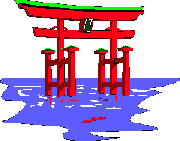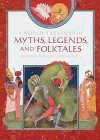 |
 Kokeshi dolls are traditionally simple in construction, made of wood, and shaped with a cylindrical body and round head. They originated as a childe's toy in the Tohiku region of northern Japan. Kokeshi are usually limbless and painted in bright floral designs, kimoni, or in other traditional patters. Due to its adorable looks, zealous kokeshi collectors can now purchase the doll all over Japan. Traditional kokeshi can be classified into probably 10 categories based on manufacturing technique, shape, and decoration. In addition, "contemporary" kokeshi are now making the scene, incorporating elements of modern art and sculpture. Kokeshi is now recognized as one of the traditional folk arts in Japan. (Available from here)
 These red , roly-poly dolls are called Daruma. They are a depiction of the Indian priest Bodhidharma, who introduced Zen Buddhism to China from India. It is said that he lost the use of his arms and legs after spending nine years meditating in a cave. The daruma dolls are heavy on the bottom and bounce back when tipped over, so it has become a symbol of optimism, good fortune and strong determination. Usually daruma dolls are sold without the eyeballs painted in. People paint in one eye when they set out to do something and paint in the other one when they have achieved the goal. (Also available from here)
BOOKS OTHER LINKS Wish List Must have (maybe make) an indoor fountain as soon as very possible!
Check out THIS SITE. It is an absolute MUST to learn about how to build your own indoor fountain. Other excellent sites on this subject can be found on the Indoor Fountain Webring. |
FENG SHUIFeng Shui is the ancient Chinese art of placement and the concept of chíi. Chíi symbolizes the breath of nature, a life force inside all living things. It is an invisible energy that is constantly circulating, however it does tend to gather in certain places. Feng Shui is becoming increasingly popular throughout the western world, although it has been a way of life in China for centuries. It is a system of arranging your home and workplace to provide the most beneficial and healthy environment. Items (some of which are described below) are used to act as 'cures' or 'remedies', activators, tools or enhancements and all are said to have qualities to improve any home, workplace or building. Some people swear by the benefits obtained by practising a little of this, others are sceptical about the benefits but like having these knick-knacks around the home anyway(!). Examples Moon Frog
Dragon
Mandarin Ducks Regarded by the Chinese as symbolic of fortunate partnerships and marriage, they are therefore only used in pairs. Benefits: Romantic energy, loyal and long lasting marriages and partnerships, and also to attract a partner for single people. Positioning and Use: Use in Relationships sector of the house, bedroom or living room. To attract a partner, the ducks should face each other. To preserve a partnership, they should be alongside and face the same way. It is essential not to have a single duck and never more than one pair of ducks in one room. Windchimes As Feng Shui means 'wind and water' the windchime is a natural enhancement with many qualities. Benefits: Attracts, energises and prevents Chi flowing too quickly, thus reducing stress and antagonism. It is also beneficial to health. Chinese windchimes often carry symbols relating to different benefits, wealth, good fortune, love and others. Positioning and Use: Often hung in a hallway, corridor to slow and activate the Chi, they can also be auspiciously positioned in any room. Laughing Buddha
Indoor Water Features Water is a primary feature of Feng Shui (meaning, remember, 'wind and water'), and is a recommendation of virtually all Feng Shui consultants. The natural flow of moving water is one of the very best methods of activating and encouraging beneficial Chi. Benefits: Most auspicious for general well being and a healthy environment. It assists in healing relationships, resolving disputes. Moving water also attracts wealth. Positioning and Use: Can be placed in any area. Best in the North, East or South-East. There are many different ways to improve chíi, but water is both the literal and symbolic source of life. Slow moving water allows chíi to accumulate, or even be formed. That is where fountains come in. depending on their placement, fountains can enhance different aspects of your life and improve your overall mental health. Phew! There is so much more! Do get yourself a book, or check out the following interesting links. It is my (personal) belief that none of this should be taken too seriously (for fear of disappointment and failure) - but the addition of some of all of these items into your home is sure to enhance it and make it a more enjoyable place to be in any case.
 Living Designs Feng Shui and much else (UK)

|
MANEKI NEKO
Maneki Neko is a cat figurine. However, it is not just any kind of cat figurine. The one which sits and has it's front paw raised as if it is calling for someone is the only one that can be called a " Maneki neko". It just sits in your house or in your store. But it does bring the luck, the fortune and the customers into your store. It does invite the happiness to your home! It works as a kind of lucky charm ( something like a St. Christopher's charm) in Japan. THE ORIGIN
The gesture of Maneki Neko looks like it is inviting someone. It is actually representing a gesture of a cat washing its face. The best Maneki Neko range and the easiest to buy I have come across are at the JUN Japanese Gifts and Souvenir site
 This demure little creature is called "fukufuku" - no kidding!! |












